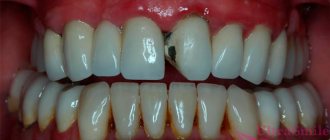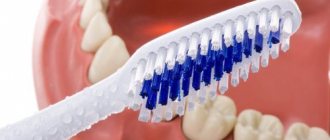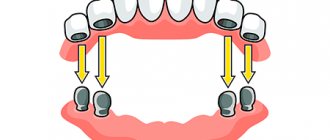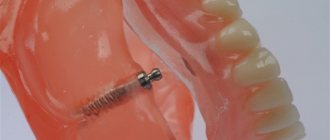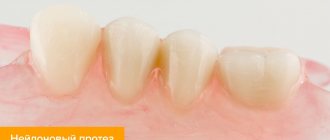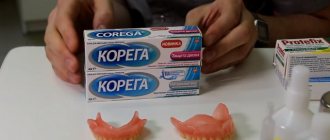The most common service in dentistry is prosthetics. If the dentist performs it correctly, a person’s teeth will become straight and their smile will be attractive. Since a large load is created on the jaw during chewing, situations may occur in which structural elements are damaged. You need to figure out how to fix a denture at home without resorting to the services of a dentist.
When to repair a structure
The materials in dentures are highly durable, but over time they can wear out or even break. Many people who use a prosthesis every day experience damage that requires emergency repairs.
There are the following reasons why device correction may be required:
- the crowns acquire a defective shade, for example, yellow or brown;
- the appearance of discomfort, pain, which previously did not bother the patient when using the structure;
- detachment, crack, puncture, peeling or other defects causing discomfort or loss of function;
- mechanical damage when clenching teeth, chewing hard elements.
If a breakdown occurs, it is better to contact your dentist directly so that he can repair the product without causing further defects. But there are times when immediate contact with a specialist is impossible. For example, if a person is away. Then temporary repairs can be done at home.
It is important not to damage the structure yourself, since repairing it will cost much less than buying a new prosthesis. There may also be breakdowns that a person cannot handle, for example, if repairs require the use of specific medical instruments.
Fixing powder
It is made from sodium alginate, which contains natural substances that are biologically compatible with living gum tissue. The principle of using the powder is the same as that of a cream or fixing pad. A small amount of fixing powder is applied to the previously cleaned denture, the device is immediately put on the teeth and bonding occurs. Fixing powder, unlike fixing creams or pads, is usually available without aromatic or flavoring additives.
Damaging factors
The use of dentures is very convenient for people who have lost part of their teeth or the entire dentition. This is a life-saving design, thanks to which the chewing function is fully restored. If it is installed in a timely manner, there will be no defect in the soft tissues or jaw bones. After installation, the dentist warns about the following features:
- rules of daily care;
- possible types of defects for which you will need to seek help from a dentist;
- rules for installing and removing the structure.
A small defect or complete breakdown of a denture can happen at the most inopportune moment. this :
- end of service life;
- impact on various objects, hard surfaces, which occurs when removing or installing a prosthesis;
- improper manufacturing of the system, use of low-quality materials;
- the appearance of bubbles that remain between the prosthesis and the person’s own tissues makes it difficult to use the prosthesis.
If a denture breaks, the patient may not notice it and will continue to use it. This may lead to the following consequences:
- damage to a person’s own tissues, for example, if a chip appears on the prosthesis;
- worsening defects on the prosthesis, for example, a small crack can lead to a complete split of the structure.
Both part of the structure and the entire product may break. It all depends on the extent of the damage. It is necessary to quickly make a decision on the repair method in order to prevent complications and maintain the integrity of the structure.
Creams and gels
Fixing a denture with cream or gel, which to choose? Both of these remedies are identical in their effectiveness and method of use. The only difference between them is the greater fluidity of the gels with the ability to form a thinner layer. Creams have a denser consistency and contain an additive of aromatic oils.
Rules for the use of gels and creams for dentures
Typically, experts recommend using creams to fix dentures immediately after prosthetics because of their ease of dosing and use.
But the amount of gel is more difficult to correctly calculate. If you increase its amount, the gel will not harden and hold the prosthesis normally.
Creams are applied to the lower segment of the denture, which is then pressed firmly against the gums. The creams reliably fix the structure for 12-24 hours.
The cream is especially recommended for patients with excessive salivation.
The most common and high-quality fixation creams are Rocs, Lacalut, Protefix, President, Corega, etc.
To choose the right means of fixation, you need to know such subtleties
- It is better to choose gels and creams with neutral scents. Fragrances in them are contraindicated for people with allergies.
- Preference should be given to waterproof products due to their longer action and better tightness. Waterproof types of compositions better protect against the penetration of food under the prosthesis and the development of unpleasant odors or inflammation.
- It is better to avoid using products containing zinc due to its toxic effect on the body (nervous and skeletal systems).
- Products with a gel-like consistency are more economical due to the ability to form a thinner layer during fixation.
Recovery Features
Many people are afraid to go to the dentist when defects appear, because they believe that repairs will be expensive. But it is better to repair a small defect in a timely manner than to completely replace the structure. Features of the restoration of the product depend on the cause of the damage and the degree of development of the defects. The recovery method takes place in stages:
- Removal and inspection of the structure
. If there are particles of dirt on the surface, the structure is completely cleaned. - Uses of Dental Resin
. Damaged particles stick together to create a sealed state. You can achieve an appearance that does not differ from the original quality. - Evaluation of the shade of the structure
. Its color is affected by drinking caffeine and strong tea, and smoking cigarettes. If contamination is detected, the surface must be cleaned. This should only be done by a dentist using specialized medical solutions. He will achieve the original, ideal shade of the crowns. - Chips of a small part or the entire crown
. There is no need to worry about this; even if a large part of the column breaks off, it can be restored. For this purpose, they turn to a dental technician to strengthen the broken product into place.
If a piece breaks off from a denture, you should not throw it away. Together with him, they contact a dentist or dental technician, he will help restore the integrity of the structure.
Comments
What if my prosthesis breaks six months after the prosthesis? Who will pay me for the pleasure of repairing or replacing it? Isn't it the clinic itself?
Maria Ivanovna (05/27/2021 at 00:35) Reply to comment
- Dear Maria Ivanovna, if the case is within the scope of the warranty and service provided in the contract with the clinic, then, yes, the repair or replacement of the prosthesis will be carried out at the expense of dentistry. Typically, orthopedic products are provided with a warranty for a period of 1 to 3-5 years (each clinic individually, not to be confused with the service life of prostheses!). If during this period the prosthesis breaks due to the fault of the clinic specialists, for example, it was poorly manufactured and installed, then the patient can count on free repairs and replacement. At the same time, it is very important that the patient observes all the conditions under which the warranty obligations will be fulfilled, and does not try to repair the prosthesis on his own or in a third-party organization. Otherwise, the clinic has the right to refuse to provide free services.
Reply from the author of the article (05/30/2021 at 09:18) Reply to comment
Hello. Tell me what can cause a removable denture to become deformed (not crack) and how long does it take to restore such a denture? And what kind of food is considered super hard to avoid damage.
Olga Ivanovna (07/08/2021 at 08:22) Reply to comment
What to do if the denture rubs the gums? About a month of using the prosthesis passed and it began to rub the gums and, accordingly, it became painful to bite.
Olga (07/08/2021 at 09:50) Reply to comment
Hello. I had prosthetic teeth in one clinic, but after 8 months the prosthesis broke. I went to another clinic to have the prosthesis repaired or a new one made. But the doctor said that a new one was needed, since the prosthesis was made from low-quality materials. The previous clinic said that they were made of metal, but in fact it turned out that they were made of metal-plastic. The clinic where I did it initially is not there. But there was a 1 year warranty. Please tell me how to identify a prosthesis, what it is made of, and what to do in this situation.
Alexey (07/08/2021 at 11:33) Reply to comment
My mother’s dentures are becoming unusable, but she is in no hurry to change them yet, since this is not a cheap procedure, although she feels discomfort. Tell me, is it dangerous for the integrity to delay this or not?
Ekaterina (07/08/2021 at 11:57 am) Reply to comment
I must admit, at first I thought about false plastic dentures. But no, this is about metal ceramics. Tell me, what percentage of patients with crowns turn to orthopedists with a similar problem?
Lesya (07/08/2021 at 12:10) Reply to comment
Due to injury, the face has a displacement in the jaw area. Tell me, please, can a prosthesis be made in full accordance with the broken symmetry? And won’t there be discomfort in the future, because there are a lot of movements during the day?
Denis (04.08.2021 at 16:24) Reply to comment
If a metal-ceramic crown begins to change color, does this indicate that it is deteriorating, or is the problem purely aesthetic? Will replacing the product directly harm the tooth?
Sonya (08/04/2021 at 18:19) Reply to comment
Tell me, I have a metal-ceramic crown. Recently, under the crown, I have noticed that the gums have darkened. This indicates that it is time to change the crown, has it become unusable? Perhaps there is an option for cleaning the gums under the crown? Or is it a gum problem?
Maria (08/05/2021 at 12:07 pm) Reply to comment
Write your comment Cancel reply
Bonding materials
In the process of creating a crown, only materials with a high degree of strength are used. But even in this case, small chips and cracks are possible. You can eliminate them yourself. But it is important to understand that home renovations are only a temporary measure. As soon as the patient has the time and opportunity, he should see a dentist.
If repairs are initially carried out at home, dentists give the following recommendations:
- Preheat the device to allow the wax to melt. This technique is typical only for removable structures, so as not to damage a person’s own tissue.
- Giving the correct shape to the gypsum base. It should be cone-shaped. To change the shape, the prosthesis is repeatedly exposed to heat.
- When the device has cooled, the gluing area is treated with sandpaper so that there are no rusty particles left on the surface that scratch the gums.
- Fastening the fallen part of the crown to the structure. It is important to place it in the exact location, not to mix it up, otherwise severe discomfort will occur.
- Bonding the crowns and the base of the structure using wax or other auxiliary material. The glue must be reliable, but safe, it must not damage the device.
- Wait for the structure to dry and cool. The adhesive substance should not get on the soft tissues in the person’s mouth. The remaining excess wax that has spread around the edges is removed.
Bonding may require more than just wax. To achieve a more stable fixation, it is recommended to purchase special glue from a dental store. It is intended specifically for dentures. Once glued, the device can be reused, but it is important to understand that this will not last long. The structure glued in this way can be damaged again, so it is important to consult a doctor in a timely manner. It is unacceptable to further damage the system during repairs, otherwise restoration of integrity by the dentist may not occur.
Problem #2: The bridge is broken
Classic bridges are permanent structures consisting of at least 3 crowns, two of which rest on the teeth remaining in the mouth, and one imitates the missing element. Bridges can also be adhesive and cantilever. These consist of a tooth-replacing crown (or several crowns) and attachments extending from it (clasps, “wings” made of fiberglass and metal tape, special inlays) that are fixed to the “supports.” These orthopedic products fail quite often.
Nature of defects
- exactly the same chips, cracks and shade changes as with conventional crowns,
- breakage, peeling off of fastening elements of adhesive and cantilever bridges,
- mobility of the bridge, formation of gaps between it and the gum,
- fracture at the base of the product.
A gap may form between the bridge and gum
How the problem is solved
In the case of chips and cracks on the crowns of the bridge, repair of dentures is carried out using composite materials. If the fasteners of adhesive structures break, then in some cases it is possible to replace them with new ones, if appropriate. For example, if the replacement crown itself was made of a durable material (ceramics, zirconium dioxide), and not of a composite.
If your composite bridge fasteners break 2 years after the start of its operation, then the material itself must be replaced. That is, in this case it is better to make a new design.
Many patients note that 3-5 years after treatment, the bridges lose stability, begin to wobble, shift, and a gap appears between them and the gum. This spoils the aesthetics of the smile and disrupts functionality. In this case, is it possible to carry out urgent repairs of dentures or their correction to correct the situation?
No, because the cause of the problems in this case is the inevitable atrophy of the bone tissue under the structure, as well as the premature destruction of the supporting teeth, which bear a serious load. And the only way out here is to remove the old devices, carry out additional therapeutic, surgical and periodontal treatment, and then install new devices, which will be made according to the changed clinical situation in the mouth.
If there is a fracture at the base of the bridge, the structure will have to be completely changed.
Removable denture repair
To carry out the repair procedure yourself requires skill and a little experience. The patient must decide whether he can eliminate the defect on his own, or whether it is better to go straight to the dentist. There are certain risks in the process of such actions:
- greater damage to the device;
- improper repair leading to malocclusion;
- the presence of chips and rough surfaces that cause damage to adjacent soft tissues.
If you repair the product yourself, you may not be able to fully restore its functionality.
If you contact a professional dentist and dental technician in a timely manner, the product can be completely repaired in a few days and its functions will be restored. The integrity of the structure is restored in full. To do this, dentists follow step-by-step instructions in restoring the integrity of the prosthesis using medical equipment.
Repair instructions for plate dentures:
- Detection of a defect, application of the damaged structure to the location. Fixation is carried out using sticky wax or medical glue.
- Application of an insulating agent. It is installed from the side of the prosthetic bed. This prevents the plastic structure and plaster from sticking together. You cannot do this with your hands; use a brush or brush.
- Formation of a fixing model from plaster. Only top class materials are used. The denture needs to be divided and the fracture lines processed with a micromotor or cutter. Individual parts of the structure are installed using a fixing model. The dentist ensures that the distance between the fixation models in the area of the fracture does not exceed 3 mm.
- Forming a fold. The bevel angle should be 45° in relation to the base of the device. This will create a smooth transition between the old and new areas of plastic. They will be connected in a better shape.
- Application of an insulating agent. It is used on the surface of plaster so that the adhesive material does not absorb liquids spreading from plastics. Otherwise, large pores will form. As soon as the parts of the prosthesis have been fixed with monomer, they begin to knead the plastic. This action occurs in stages.
- The plastic prepared according to plan should swell. It is transferred to the prosthetic areas with a reserve. Then press a little with your fingers. The resulting product is transferred to the apparatus to polymerize the plastic.
At the final stage, excess plastic must be removed. For this purpose, a micromotor and a press are used. The surface is leveled with medical instruments intended for grinding. After polishing the surface, the product is treated with antiseptic solutions. It is ready to use.
The most common causes of failure of orthopedic products
Problems can arise due to overloading of systems, eating too hard food, due to changes in the temperature of the food eaten (cold and hot), due to impacts and injuries, inadequate hygiene care, as well as the use of inappropriate hygiene products (highly abrasive and bleaching pastes, brushes). with hard bristles).
If defects appear after several years of wearing orthopedic devices, this may mean that the materials from which they were made have become unusable. After all, any material has its own permissible service life: for plastic, acetal, silicone, nylon - 2-5 years, for metal-plastic - 3-5 years, for ceramics - 5-7 years, for metal and metal-ceramics - about 7-10 years , for zirconium dioxide and ceramic composite – from 15 years or more.
Recovery technique in the clinic
At the dental clinic, the doctor initially examines the device visually. It should be examined by a dental technician. If pieces of food and other foreign objects are stuck in the denture, pre-clean it. Only after this can you accurately see all the defects and begin the restoration of the structure. If you exclude the cleaning step, the adhesive will not be able to completely fix the broken product. Then the repair procedure will be ineffective. Only after cleaning can high-quality sealing be achieved.
If the defects in the device are excessively large, the dentist will recommend completely replacing the structure. This is due to the following features:
- saving money, since repairs may require similar financial resources as major repairs;
- the possibility of a lack of quality effect during repairs; the base will continue to break, damage tissues, and disrupt the bite.
Only if minor chips or cracks appear on the prosthesis, it can be restored. For example, if a small chip occurs on the crowns, remove the device and fix it. Why install the crown in place? The result should be a product that is not inferior in function to new prostheses.
Many patients believe that they can handle the repair themselves. But there is a big difference between home bonding and professional services. At home, you can make a little adjustment to the design before going to the dentist. Complete repairs can only be carried out by a competent dental technician. He must have specialized tools at hand in order to carry out high-quality restoration.
The patient does not have solutions or tools at home that will return the whiteness to the crowns on the prosthesis. Periodically, it is necessary to restore the shade in order for the prosthesis to perform an aesthetic function. It should completely replace the appearance of real teeth.
It is not always possible to achieve high-quality restoration after repair, even from a dentist. For example, if a stamped device or a product without metal is damaged, it cannot be repaired.
Contraindications
Denture adhesive is a completely safe product that can be applied by absolutely anyone who does not have individual tolerance. Be careful to apply the product in small quantities, otherwise when you press the jaws it will peek out from under the denture. When used correctly, there is no harm to the body or the structure itself. Only occasionally can an overdose occur, which is characterized by the following symptoms:
- feeling of nausea;
- increased salivation;
- drowsy state;
- feeling of weakness;
- dizziness;
- allergic reaction.
If one of the presented signs occurs, you must immediately visit the clinic.
To protect yourself from such phenomena, you need to take certain precautions. You can use a fixation device only after it has been recommended by a doctor. Use it strictly according to the instructions. Store it in a place where a child's hand cannot reach. The packaging should not be exposed to moisture, and storage should take place at room temperature. These rules are not that difficult to follow, but they will allow you to protect yourself from adverse events and achieve reliable, long-term fixation of the dental structure.
Sources used:
- First St. Petersburg State Medical University named after. acad. I.P. Pavlova
- Official website of the Russian Dental Association
- Milward, P.; Katechia, D.; Morgan, M. Z. (November 2013). "Knowledge of removable partial denture wearers on denture hygiene". British Dental Journal.
Repair price
The cost of restoring the quality of a denture after repair depends on the following factors:
- the complexity of the work performed by a dental technician;
- product material;
- area and degree of damage.
For example, if a patient’s metal-ceramic structure is slightly broken, repairs can reach up to 2,000 rubles.
The following approximate price list is highlighted:
- installation of a new artificial crown - 2500 rubles;
- professional cleaning and whitening of crowns, basics of the device - 1000 rubles;
- restoration of crown shade when drinking coffee, after prolonged smoking - 1200 rubles.
If you carry out the restoration yourself, the price will be significantly lower, but the entire structure will not be able to regain its original appearance. The damage may recur or continue to get worse.
Corega
Using Corega is very convenient, as the tube has a special tip that allows you to apply exactly the required amount of product. The composition contains petrolatum, gum, zinc, paraffin, they are safe for the human body.
There are three varieties of "Korega":
- "Refreshing taste." Available in two versions: with and without zinc. Gently fixes, has a mild mint taste, suitable for gums that need careful care.
- “Extra strong. Mint". Provides maximum adhesion thanks to the gum arabic it contains. Contains dyes that make the product pale pink, close to the shade of gum.
- "Neutral taste." Does not contain zinc or additives that affect the sense of taste. Zinc is replaced by a naturally occurring resin called gum arabic.
When using the product, reliable fastening is achieved for a maximum of 24 hours. Food does not get under the prosthesis, which reduces the likelihood of inflammatory processes in the oral mucosa.
Advantages:
- is inexpensive;
- application does not cause difficulties;
- Can be used for wet dentures.
Flaws:
- quickly washed off with water;
- with prolonged use (wearing a prosthesis), the oral mucosa may swell;
- the product is dissolved by drinks and food, which causes an increased risk of the structure falling out of the mouth and reduces the duration of use from 24 to 12 hours.
